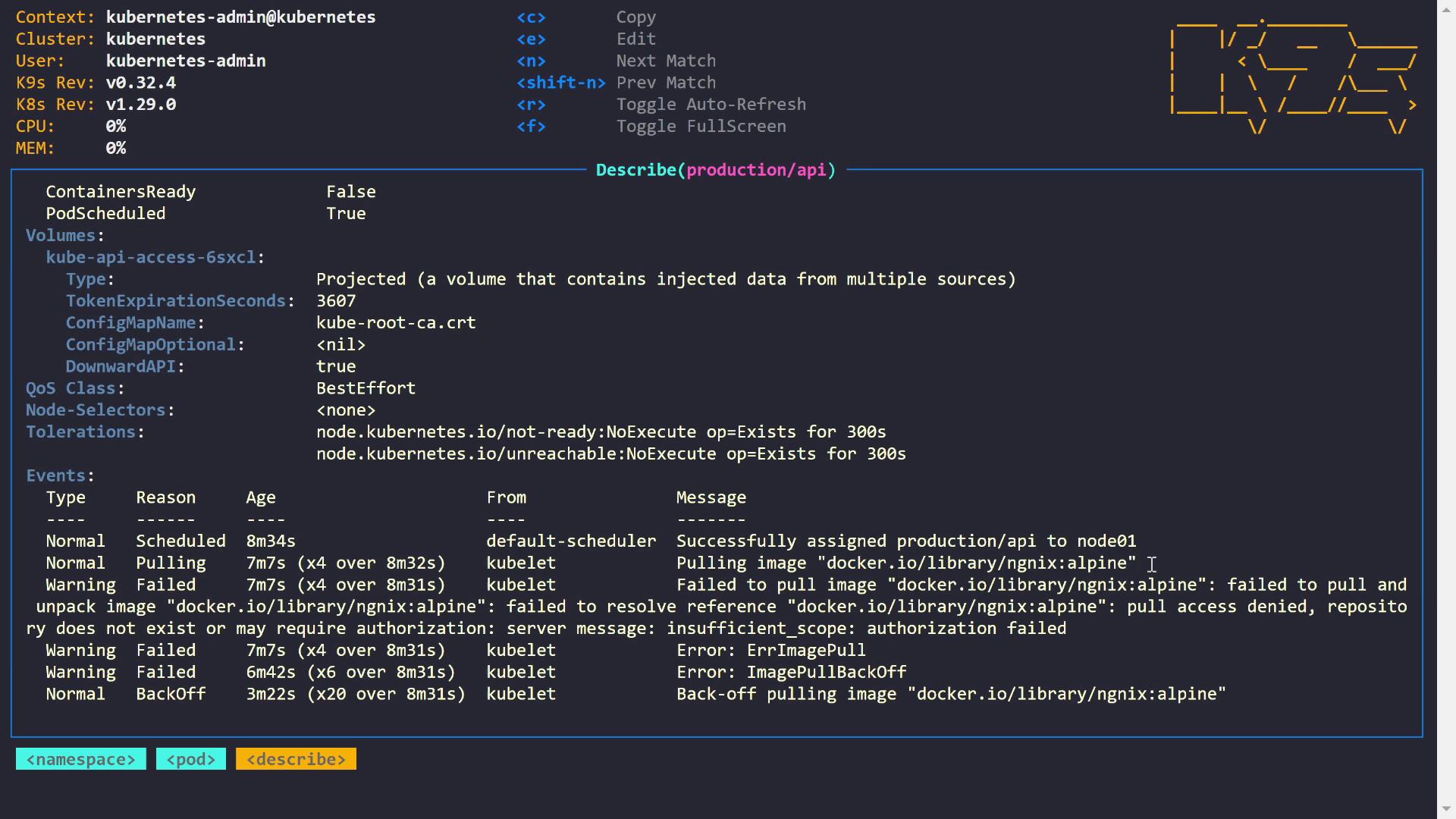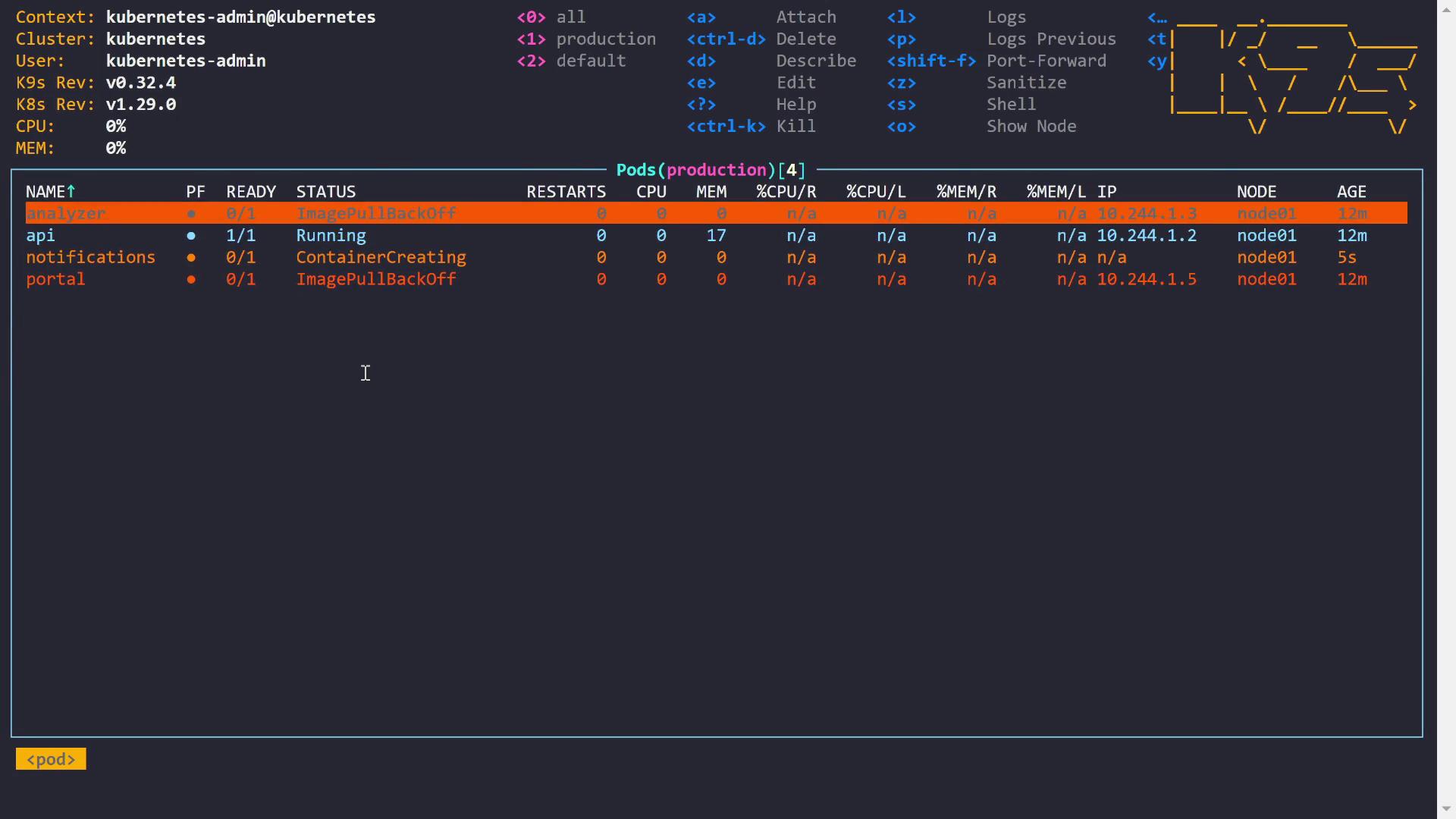Kubernetes Troubleshooting for Application Developers
Troubleshooting Scenarios
Image Pull Errors
Welcome to this guide on resolving common image pull errors in Kubernetes. In this article, we will explore issues that can occur during image pulls, including typos in image names, missing credentials, incorrect tags, and DNS resolution errors. Whether you're new to Kubernetes or an experienced user, this step-by-step guide will help you diagnose and fix these problems.
Overview
When a pod is stuck in an image pull error state, it means that Kubernetes tried to fetch the container image, encountered an error, and then applied an exponential backoff before retrying. This mechanism helps prevent network congestion and registry overload.
Pod Status Example
Below is an example of a pod status showing the error:
NAME PF READY STATUS RESTARTS CPU MEM %CPU/R %CPU/L %MEM/R %MEM/L IP NODE AGE
analyzer 0/1 ImagePullBackOff 0 0 0 n/a n/a n/a n/a 10.244.1.3 node01 8m
api 0/1 ImagePullBackOff 0 0 0 n/a n/a n/a n/a 10.244.1.2 node01 8m
notifications 0/1 ImagePullBackOff 0 0 0 n/a n/a n/a n/a 10.244.1.4 node01 8m
portal 0/1 ImagePullBackOff 0 0 0 n/a n/a n/a n/a 10.244.1.5 node01 8m
Each retry increases the delay before the next attempt.
1. Investigating a Pod with an Image Pull Error
Let's start by inspecting one of the pods that is not starting correctly. In this section, we describe the API pod to look at the events, which illustrate that the image pull error is due to an unresolved image reference.

The events reveal that the cluster scheduled the pod correctly but failed to pull the image because the reference could not be resolved. Common error messages include "pull access denied," "repository does not exist," or messages indicating the need for authorization.
Example: Fixing a Typo in the Image URL
In this example, the pod uses an image sourced from Docker Hub. Upon checking, a typo was discovered in the image name ("NGINX"). Correcting the typo will resolve the issue.
Below is the updated pod definition:
apiVersion: v1
kind: Pod
metadata:
annotations:
kubectl.kubernetes.io/last-applied-configuration: |
{"apiVersion":"v1","kind":"Pod","metadata":{"annotations":{},"labels":{"app":"api"},"name":"api","namespace":"production"},"spec":{"containers":[{"image":"docker.io/library/nginx:alpine","name":"api","resources":{},"terminationMessagePath":"/dev/termination-log","terminationMessagePolicy":"File"}]}}
creationTimestamp: "2024-05-06T22:50:59Z"
labels:
app: api
name: api
namespace: production
resourceVersion: "71898"
uid: 823d9b4c-5ed8-44c9-9c3c-847f5286810c
spec:
containers:
- image: docker.io/library/nginx:alpine
imagePullPolicy: IfNotPresent
name: api
resources: {}
terminationMessagePath: /dev/termination-log
terminationMessagePolicy: File
volumeMounts:
- mountPath: /var/run/secrets/kubernetes.io/serviceaccount
name: kube-api-access-6sxcl
readOnly: true
dnsPolicy: ClusterFirst
enableServiceLinks: true
nodeName: node01
preemptionPolicy: PreemptLowerPriority
priority: 0
After saving this configuration, the pod status updates to:
NAME PF READY STATUS RESTARTS CPU MEM %CPU/R %MEM/R %CPU/L %MEM/L IP NODE AGE
analyzer 0/1 ImagePullBackOff 0 0 0 n/a n/a n/a n/a 10.244.1.3 node01 9m49s
api 1/1 Running 0 0 0 n/a n/a n/a n/a 10.244.1.2 node01 9m49s
notifications 0/1 ImagePullBackOff 0 0 0 n/a n/a n/a n/a 10.244.1.4 node01 9m49s
portal 0/1 ImagePullBackOff 0 0 0 n/a n/a n/a n/a 10.244.1.5 node01 9m49s
2. Resolving Credential Issues for Private Registries
The next issue involves the notifications pod, which faces a 401 Unauthorized error while pulling an image from the GitHub Container Registry (ghcr.io). A 401 error generally indicates missing or invalid credentials.
Check the Image Pull Secrets
Inspect the pod's events:
Events:
Normal Scheduled 9m56s default-scheduler Successfully assigned production/notifications to node01
Normal Pulling 8m24s kubelet Pulling image "ghcr.io/testuser177/solar-system:3cd635a2ae17224806363eb3a4d565623650efb1"
Warning Failed 8m24s kubelet Failed to pull image "ghcr.io/testuser177/solar-system:3cd635a2ae17224806363eb3a4d565623650efb1": failed to resolve reference "ghcr.io/testuser177/solar-system:3cd635a2ae17224806363eb3a4d565623650efb1": failed to authorize: failed to fetch anonymous token: unexpected status from GET request to https://ghcr.io/token?scope=repository%3Atestuser177%2Fsolar-system%3Apull&service=ghcr.io: 401 Unauthorized
Warning Failed 8m24s kubelet Error: ErrImagePull
Warning Failed 8m12s kubelet Error: ImagePullBackOff
Normal Backoff 4m47s kubelet Back-off pulling image "ghcr.io/testuser177/solar-system:3cd635a2ae17224806363eb3a4d565623650efb1"
A quick check confirms that the required secret for ghcr.io (named "ghcr-secret") does exist:
NAME TYPE DATA AGE
ghcr-secret kubernetes.io/dockerconfigjson 1 10m
Note
Since you're editing a pod directly (instead of a Deployment), some fields cannot be updated on a running pod. You must delete the pod and reapply the updated configuration.
Updated Notifications Pod Definition
Below is the updated configuration with the image pull secret added:
apiVersion: v1
kind: Pod
metadata:
annotations:
kubectl.kubernetes.io/last-applied-configuration: |
{"apiVersion":"v1","kind":"Pod","metadata":{"annotations":{},"labels":{"app":"notifications"},"name":"notifications","namespace":"production"},"spec":{"containers":[{"image":"ghcr.io/testuser177/solar-system:3cd635a2ae17224806363eb3a4d565623650efb1","name":"notifications","imagePullPolicy":"IfNotPresent","resources":{},"terminationMessagePath":"/dev/termination-log","terminationMessagePolicy":"File","volumeMounts":[{"mountPath":"/var/run/secrets/kubernetes.io/serviceaccount","name":"kube-api-access-mh4xz","readOnly":true}]}]}}
labels:
app: notifications
name: notifications
namespace: production
spec:
imagePullSecrets:
- name: ghcr-secret
containers:
- image: ghcr.io/testuser177/solar-system:3cd635a2ae17224806363eb3a4d565623650efb1
imagePullPolicy: IfNotPresent
name: notifications
resources: {}
terminationMessagePath: /dev/termination-log
terminationMessagePolicy: File
volumeMounts:
- mountPath: /var/run/secrets/kubernetes.io/serviceaccount
name: kube-api-access-mh4xz
readOnly: true
dnsPolicy: ClusterFirst
enableServiceLinks: true
nodeName: node01
preemptionPolicy: PreemptLowerPriority
priority: 0
Steps to Apply the Change
Export the current pod configuration:
kubectl get -n production pod notifications -o yaml > notifications.yamlDelete the existing pod:
kubectl delete pod -n production notificationsApply the updated configuration:
kubectl apply -f notifications.yaml
After applying the changes, verify the pod status using a CLI tool like K9s.

The notifications pod should now be in a Running state.
3. Correcting Image Tags and Resolving DNS Issues
The portal pod experienced image pull errors due to an incorrect image tag. In the pod description, the following error was observed:
Failed to pull image "docker.io/library/httpd:bookstore": rpc error: code = NotFound desc = failed to pull and unpack image "docker.io/library/httpd:bookstore": not found
Although the repository is correct ("docker.io/library/httpd"), the tag "bookstore" does not exist. A quick check on Docker Hub confirms the correct tag should be "bookworm" (or another valid tag). After correcting the tag in the pod definition, the portal pod successfully starts.
Additionally, another pod faced DNS resolution issues with a long image reference from "gitlab.kodekloud.com". The error message showed:
failed to resolve reference: dial TCP ...: lookup gitlab.kodekloud.com: no such host
Running a local nslookup confirms that the hostname cannot be resolved:
nslookup gitlab.kodekloud.com
Warning
Since the cluster cannot resolve the hostname, you will need to coordinate with your networking team or cluster administrators to fix the DNS issue.
Summary of Common Image Pull Error Scenarios
| Scenario | Cause | Resolution |
|---|---|---|
| Typo in Image URL | Incorrect spelling in the image name (e.g., "NGINX" typo) | Update the image URL to the correct spelling |
| Missing Image Pull Secrets | 401 Unauthorized error when accessing a private registry | Ensure valid image pull secret is configured and applied |
| Incorrect Image Tag | Specified tag does not exist (e.g., "bookstore" instead of "bookworm") | Update the pod definition with the correct image tag |
| DNS Resolution Issue | The cluster cannot resolve the container registry hostname | Coordinate with networking teams to resolve DNS issues |
Conclusion
In this guide, we walked through several common issues that lead to image pull errors in Kubernetes, including:
- Typos in the image URL.
- Missing or misconfigured image pull secrets for private registries.
- Incorrect image tags.
- DNS resolution errors.
It is essential to verify application details, ensure image URL correctness, and configure proper credentials before troubleshooting such issues. Happy troubleshooting!
For more Kubernetes resources, check out the Kubernetes Documentation and Docker Hub.
Watch Video
Watch video content
Practice Lab
Practice lab